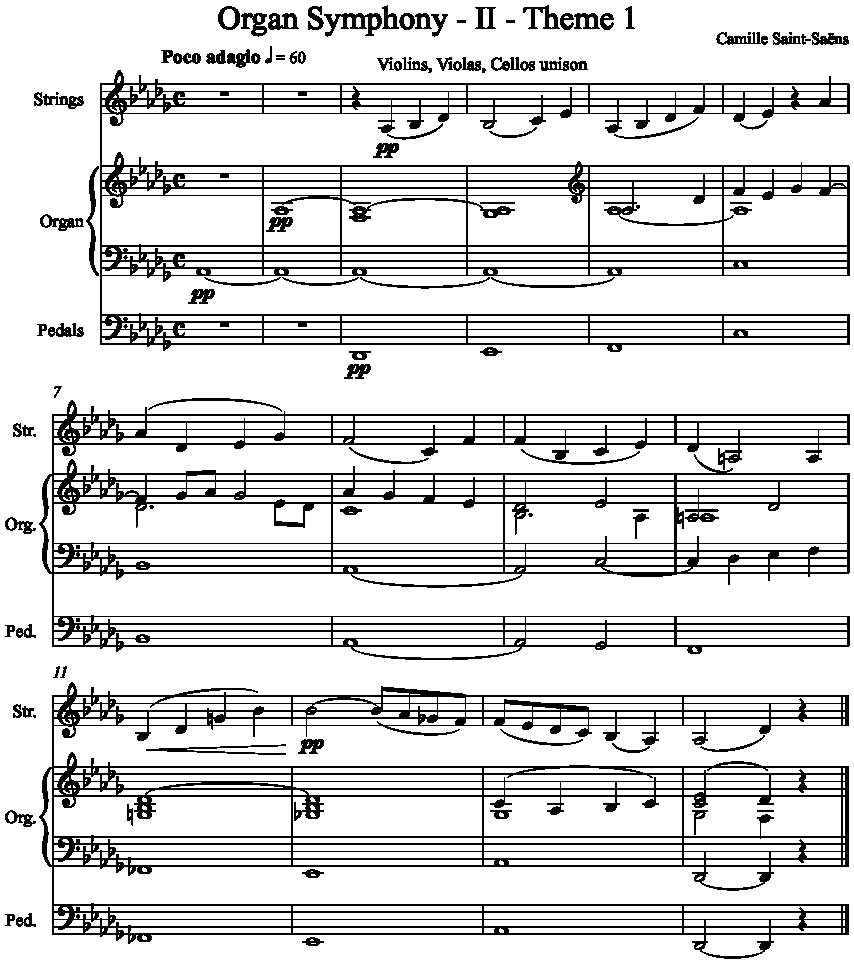
Symphony No. 3, Organ - Camille Saint-Saëns
Organ and Orchestra
 |
Symphony No. 3, Organ - Camille Saint-Saëns |
Organ and Orchestra |
Symphony No. 3, better known as the “Organ Symphony”, by late Romantic era French composer Camille Saint-Saëns is probably the best known example of secular music for full orchestra and organ. Although he lists the symphony as having only two movements, in reality there are four, clearly separated by grand pauses with fermatas, which match the normal symphonic structure and will be the terminology here. This is true of recordings as well. The organ is featured in the second and fourth movements, presenting the organ in two different modes. In the second movement, it is used softly with flute and tibia stops to accompany themes played by the orchestra. The first example shown below introduces the main theme of the second movement played by first and second violins, violas, and cellos all in the same octave. So violins are in their lowest register, violas in their normal register, and cellos in the high and more intense sounding register. The dynamics are kept soft and all of the accompaniment is in the organ. |
Listen to Theme 1 while viewing the score: |
 |
When we hear the final statement of Theme 1, it is extended in length, a fine example of Romantic era melody. The melody itself is played by divided first violins, violas, and cellos, while the rest of the string play pizzicato triplets that continues an idea from the previous passage. The organ again leads the sustained accompaniment and is joined by horn and woodwinds about half way through the theme. The chord progression here makes nice use of augmented chords, thirteenth chords, and a couple of nice chromatic twists as it approaches its final cadence. There is a really nice coda figure of two bar repeated phrases that ends the movement. Click on the player to hear the excerpt: |
|
At the start of the fourth movement, we finally get to hear the full organ. It really grabs your attention after a long, soft transitional passage at the end of the third movement. The organ hits us with three solo chords in basic C major — tonic, dominant, tonic. The chords are marked forte in the score, but I have never heard it performed less than fortissimo. Much of the orchestra music is fugal in nature, as you see below.
Then the first theme of the movement is stated in two contrasting sections. The first time we hear divided strings play the melody accompanied by two pianists playing sextuplet arpeggios. Each phrase is completed with a timpani roll and soft organ. The second time we hear the full organ blast out the theme, articulated by triple and quadruple stops in the strings, and completed with triumphant trumpet and trombone fanfares, timpani rolls and cymbal crashes. This is one of those great moments you go to an orchestra concert to hear. For easier reading, I have converted the continually changing 6/4 and 9/4 bars of the original notation into 3/4 time. |
|
The movement goes on to a grand finale like you would expect from an Organ Symphony. And it always get a standing ovation! |